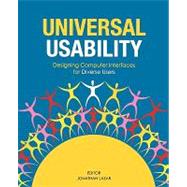Universal Usability Designing Computer Interfaces for Diverse User Populations
, by Lazar, Jonathan- ISBN: 9780470027271 | 0470027274
- Cover: Paperback
- Copyright: 6/5/2007
Universal Usability is the concept of designing computer interfaces that are easy for all users to utilize. It is a concept which many decry as elusive, impossible, or impractical, but this book, which addresses usability issues for a number of diverse user groups, proves that there is no problem in interface design that cannot be solved, or at least improved upon. Individuals with cognitive, motor, and perceptual impairments, as well as older, younger, and economically disadvantaged users, face a variety of complex challenges when interacting with computers. However, with user involvement, good design practice, and thorough testing, computer interfaces can be successfully developed for any user population. This book, featuring key chapters by Human-Computer Interaction luminaries such as Jonathan Lazar, Ron Baecker, Allison Druin, Ben Shneiderman, Brad Myers and Jenny Preece, examines innovative and groundbreaking research and practice, and provides a practical overview of a number of successful projects which have addressed a need for these specific user populations. Chapters in this book address topics including age diversity, economic diversity, language diversity, visual impairment, and spinal cord injuries. Several of these trailblazing projects in the book are amongst the first to examine usability issues for users with Down Syndrome, users with Amnesia, users with Autism Spectrum Disorders, and users with Alzheimer's Disease, and coverage extends to projects where multiple categories of needs are addressed. These chapters represent real-world projects, being carried out on different continents. The authors of the chapters also represent diversity-interface researchers and software developers in university, industrial, and government settings. In the practical spirit of the book, chapter authors provide guidelines and suggestions for those attempting similar projects, as well as implications for different stakeholders such as policymakers, researchers, and designers. Ideal for students of HCI and User Interface Design, and essential reading for usability practitioners, this fascinating collection of real-world projects demonstrates that computer interfaces can truly be designed to meet the needs of any category of user.







